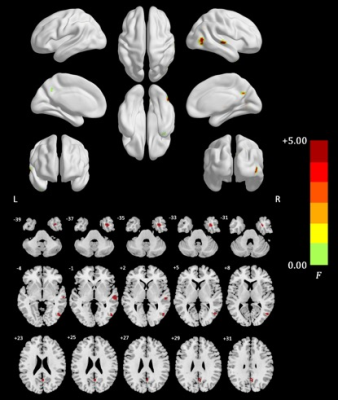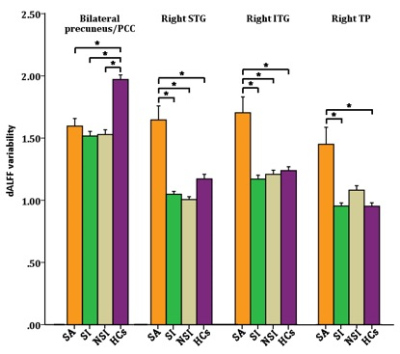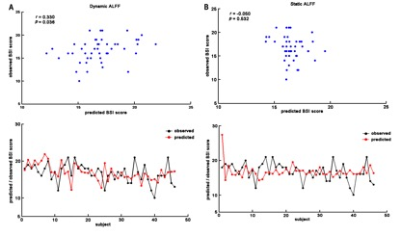3838
Characteristics of temporal dynamics of intrinsic brain activity in unmedicated bipolar II disorder with suicidality1Medical Imaging Center, First Affiliated Hospital of Jinan University, Guangzhou, China, 2Department of Radiology, Six Affiliated Hospital of Sun Yat-sen University, Guangzhou, China, 3Department of Psychiatry, First Affiliated Hospital of Jinan University, Guangzhou, China, 4MR Research, GE Healthcare, Beijing, China
Synopsis
The alterations of brain dynamics in bipolar disorder (BD) with suicidality are still unknown. Dynamic amplitude of low-frequency fluctuations (dALFF) was evaluated using sliding window analysis, and the severity of suicidality was predicted using a multivariate regression model between 106 BD II participants. Our findings suggest that alterations of temporal variability in the precuneus/ posterior cingulate cortex (PCC) is a common feature of BD participants, the right temporal lobe involved in impulsivity, social and emotional processing are associated with suicidality in BD II depression
Introduction
BD is a chronic psychiatric disorder characterized by high suicide risk. Due to the difficulties in predicting and preventing suicide, it has attracted wide attention in the field of psychiatry and public health. Neurobiologically, suicidal individuals display genetic, serotonergic, brain structural and functional differences compared with BD and HCs. However, these convergent structural and functional MRI findings relied on the assumption of the ‘static’ of the brain and did not explore the dynamic brain alterations over time in psychiatric patients with suicidality. Here we employ temporal variability of intrinsic brain activity by using dALFF on rs-fMRI in unmedicated BD II depression participants with SA, with SI, NSI and HCs. This approach is supposed to be a reflection of mental activity, which may cause high time-varying and fluctuating intrinsic brain activity.Methods
The prospective study included 106 BD II participants (20 with suicidal attempt (SA), 35 with suicidal ideation (SI), 51 without SI (NSI)) and 50 healthy controls (HCs) who underwent resting-state functional magnetic resonance imaging (rs-fMRI) between February 2016 and December 2017. We first used sliding window analysis to evaluate the dynamic amplitude of low-frequency fluctuations (dALFF). Then we predicted the severity of suicidality using a multivariate regression model.Results
One-Way ANOVA analyses revealed that the dALFF in the right temporal pole (TP), inferior temporal gyrus (ITG), superior temporal gyrus (STG), and the bilateral precuneus/posterior cingulate cortex (PCC) was significantly different among the 4 groups (Fig. 1). Post hoc comparisons revealed all BD groups showed decreased dALFF in the bilateral precuneus/PCC compared with HCs. Increased dALFF was found in the right STG and ITG in the SA group compared with the others, and in the right TP in the SA group compared with SI and HCs groups (Fig. 2, Table 1). Importantly, these temporal variabilities could be used to predict the severity of suicidality (r = 0.330, p = 0.036), whereas static ALFF couldn’t (r = -0.050, p = 0.532) (Fig. 3).Discussion and Conclusion
We applied rs-fMRI and temporal variability of ALFF to explore brain dynamics in a relatively large sample of unmedicated BD II depression with SA, SI and without SI. To the best of our knowledge, this is the first study that used a novel way to explore brain dynamics on unmedicated BD II depression with suicidality. Our findings suggest that alterations of temporal variability in the precuneus/PCC is a common feature of BD participants, the right temporal lobe involved in impulsivity, social and emotional processing are associated with suicidality in BD II depression participants. This predictive model using the dynamics of intrinsic brain activity may be helpful for clinical applications.Acknowledgements
No acknowledgement found.References
1. Baldessarini RJ, Tondo L. Suicide risk and treatments for patients with bipolar disorder. JAMA. 2003; 290(11): 1517-1519.
2. Goldstein TR. Suicidality in pediatric bipolar disorder. Child Adolesc Psychiatr Clin N Am. 2009; 18(2): 339-352.
3. Latalova K, Kamaradova D, Prasko J. Suicide in bipolar disorder: a review. Psychiatr Danub. 2014; 26(2): 108-114.
4. Undurraga J, Baldessarini RJ, Valenti M, et al. Suicidal risk factors in bipolar I and II disorder patients. J Clin Psychiatry. 2012; 73(6): 778-782.
Figures


